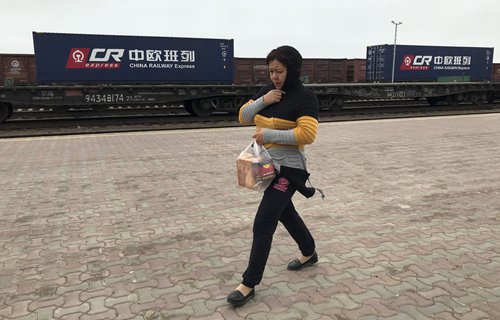
A female resident passes by China Railway Express freight containers at a train station in Khorgos along Kazakhstan's border with China in April. (Photo: IC)
○ Many local people in Central Asia hope that their countries will be more than just a transit point, but also a hub that boosts regional and even global trade
○ Many people in Central Asian countries dismissed rumors following the launch of the Belt and Road initiative that hype up a "China invasion"
○ Many local people in Central Asia hope that their countries will be more than just a transit point, but also a hub that boosts regional and even global trade
○ Many people in Central Asian countries dismissed rumors following the launch of the Belt and Road initiative that hype up a "China invasion"
A friend in need
During the week this reporter was touring in Turkmenistan, the local newspaper Neutral Turkmenistan reported on "TAPI" — a pipeline linking gas-rich Turkmenistan with Afghanistan, Pakistan and India— in great detail. Locals say that one of the reasons for Turkmenistan to embrace China is that Turkmenistan could diversify its export routes and economy.
From Turkmenistan's point of view, Russia has always been the biggest customer of Turkmenistan's natural resources. For this reason, the establishment of gas pipelines helps the country to seek alternatives.
Furthermore, new pipelines are conducive in attracting investments and know-how in order to increase domestic hydrocarbons production and develop new gas fields.
Elias, the local guide, does not believe that this TAPI move is in any way a method for his country to lessen Chinese influence.
He explained that local people do not view the Chinese presence with negativity, because China National Petroleum Corporation (CNPC) has been investing in Turkmenistan for many years, and the CAGP (Central Asia Gas Pipeline) Sino-Turkmen pipeline, which dates back to 2009, has significantly helped to break a monopoly faced by Turkmenistan.
"China is our biggest customer. They come, they buy our gas and then talk about building roads. Hopefully China can build for us a fast train linking our capital with all corners of our country," he said.
Elias hopes that transportation would be built to cut down travel time, and link major cities and towns in his country with the rest of Central Asia.
Such projects also exist in Tajikistan, the poorest of the five countries. As the recipient of many AIIB (Asian Infrastructure Investment Bank) supported projects, local driver Arivs, who frequently drives along the Pamir highway, described how a China Road and Bridge Corporation (CRBC) project linking the capital of Tajikistan all the way to Chanak at the Uzbekistan border is something that Tajikistan needs. The highway cuts through much of the country, linking major cities such as Istaravshan and Khujand.
"China is also working on hydropower plants, power lines and more. China pays much of the cost. We pay too and things are easy for both of us," said Arvis.
It is a shared opinion that the projects not only benefit both sides by opening up regional corridors and reviving the ancient Silk Road routes, they are also about seeking partnership against the backdrop of a world that is seeing increasing unrest and a stagnating economy.
Hyped up paranoia
People told the Global Times that any opportunities, initiatives and openness should be welcomed since there are always more chances for stakeholders to complement each other and seek win-win scenarios. Connectivity and cooperation is needed, against the current global backdrop of protectionism.
There hasn't been any shortage of hyped-up paranoia about the China-proposed development strategy.
Imported Chinese products were initially seen by some local people as competition for local goods. Some scholars voiced concerns that the projects might not be beneficial for ordinary people.
While it is easy to smear an ambitious open project as a "China invasion," such rumors have been dismissed by many people.
Since the beginning and even before many projects commenced, there have been voices claiming that the B&R projects wouldn't be successful, given that projects of this scale involve multiple players. But while multilateral cooperation can entice opposition, aiming for win-win situations and having concrete examples of improvements in infrastructure is more and more seen as one of the many ways to ensure greater connectivity and understanding between countries in the region and around the world.


